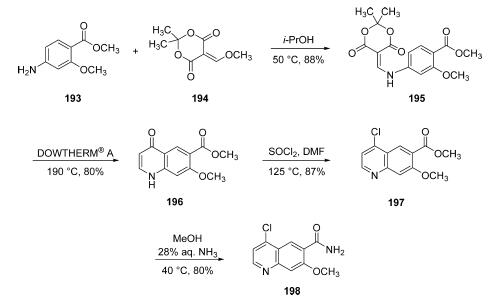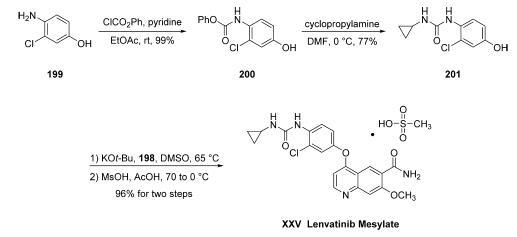ChemicalBook > CAS DataBase List > lenvatinib Mesylate
lenvatinib Mesylate
lenvatinib Mesylate
- CAS No.857890-39-2
- Chemical Name:lenvatinib Mesylate
- CBNumber:CB42651170
- Molecular Formula:C22H23ClN4O7S
- Formula Weight:522.95862
- MOL File:857890-39-2.mol
lenvatinib Mesylate Property
- Melting point >220°C (dec.)
- storage temp. -20°C Freezer
- solubility DMSO (Slightly), Methanol (Slightly)
- form Solid
- color White to Off-White
- InChIKey HWLFIUUAYLEFCT-UHFFFAOYSA-N
- SMILES O=C(N)C1C=C2C(N=CC=C2OC2C=C(Cl)C(NC(=O)NC3CC3)=CC=2)=CC=1OC.CS(=O)(O)=O
- NCI Dictionary of Cancer Terms lenvatinib mesylate
- FDA UNII 3J78384F61
- NCI Drug Dictionary lenvatinib mesylate
- UNSPSC Code 12352200
- NACRES NA.77
-
Symbol(GHS)

- Signal wordWarning
- Hazard statements H302-H315-H319-H335
- Precautionary statements P261-P305+P351+P338
lenvatinib Mesylate Price
More Price(1)
- Brand: Sigma-Aldrich(India)
- Product number: SML3017
- Product name : Lenvatinib mesylate
- Purity: ≥98% (HPLC)
- Packaging: 10MG
- Price: ₹9093
- Updated: 2022/06/14
- Buy: Buy
lenvatinib Mesylate Chemical Properties,Usage,Production
- Description Lenvatinib mesylate (lenvatinib) is an oral targeted therapy medicine known as a receptor‐type tyrosine kinase inhibitor. It is a small-molecule drug (a drug that can enter cells easily), which was developed at Eisai in 2015. It was approved by the FDA in 2015 for the treatment of differentiated thyroid cancer that is either locally recurrent, metastatic, or progressive and did not respond to radioactive iodine treatment. In May 2016, the FDA approved the drug as a combination therapy with everolimus for the treatment of advanced renal cell carcinoma. Because VEGF (and fibroblast growth factor receptors, known as FGFRs) are thought to play a role in cardiovascular signaling pathways, VEGF2R and FGFR inhibition are thought to be the mechanisms behind the primary side effect of lenvatinib mesylate, which is hypertension.
-
Uses
Lenvatinib mesylate is used in cancer:(1) Endometrial carcinoma that is advanced and got worse after other systemic therapies. It is used with pembrolizumab in patients whose cancer is not microsatellite instability-high (MSI-H) or mismatch repair deficient (dMMR) and cannot be treated with surgery or radiation therapy.(2) Hepatocellular carcinoma (a type of liver cancer). It is used as the first treatment in patients whose cancer cannot be removed by surgery.(3) Renal cell carcinoma (a type of kidney cancer) that is advanced(4)Thyroid cancer in certain patients whose cancer got worse, came back, or has spread to other parts of the body and did not respond to treatment with radioactive iodine.(5) Lenvatinib Mesylate is used in preparation of anti-human CTLA4xPD-1 bispecific antibodies for diagnosis, prevention and treatment of tumor or anemia.
Lenvatinib mesylate is also being studied in the treatment of other types of cancer.
- Uses E7080 (Lenvatinib) is a multi-target inhibitor of VEGFR2 and VEGFR3 with IC50 of 4 nM and 5.2 nM, respectively.
- Definition ChEBI: Lenvatinib mesylate is a methanesulfonate salt obtained by reaction of lenvatinib with one molar equivalent of methanesulfonic acid. A multi-kinase inhibitor and orphan drug used (as its mesylate salt) for the treatment of various types of thyroid cancer that do not respond to radioiodine. It has a role as an EC 2.7.10.1 (receptor protein-tyrosine kinase) inhibitor, a fibroblast growth factor receptor antagonist, an orphan drug, a vascular endothelial growth factor receptor antagonist and an antineoplastic agent. It contains a lenvatinib(1+).
- Mechanism of action Lenvatinib mesylate works by blocking proteins that signal cancer cells to multiply. It also blocks proteins that signal the formation of new blood vessels that are needed to support tumor growth. Blocking these signals keeps cancer cells from growing.
-
Pharmacokinetics
Lenvatinib is rapidly absorbed after oral administration, with tmax typically observed at 1 to 4 hours postdose. Food does not affect the extent of absorption but slows the rate of absorption. When administered with food to healthy subjects, peak plasma concentrations are delayed by 2 hours.
In vitro binding of lenvatinib to human plasma proteins was high and ranged from 98% to 99% (0.3 – 30 μg/mL, lenvatinib Mesylate). This binding was mainly to albumin with minor binding to α1-acid glycoprotein and γ-globulin. In vitro, the lenvatinib blood-to-plasma concentration ratio ranged from 0.589 to 0.608 (0.1 - 10 μg/mL, lenvatinib Mesylate). Lenvatinib is a substrate for P-gp and BCRP. Lenvatinib is not a substrate for OAT1, OAT3, OATP1B1, OATP1B3, OCT1, OCT2, or the BSEP. - Side effects The most prevalent AEs were hypertension (77.8%), fatigue (55.6%), weight loss (51.9%).In addition, there may be fatigue or tiredness, rashes, redness, itching or peeling of the palms and soles of the feet, diarrhoea, nausea, constipation and heartburn.
-
Synthesis
Starting from commercial aniline
193, a substitution reaction under neutral conditions in warm
isopropyl alcohol with a commercial vinyl methoxy derivative of
Meldrum?ˉs acid (194) produced enamine 195 in good yield.
Next, subjection of 195 to DOWTHERM A at 190 ??C affected
an intramolecular cyclizative substitution reaction, followed by
loss of acetone, and a decarboxylation reaction to furnish
quinolone 196. This cyclization reaction, which is a variant of
the Conrad-Limpach reaction, is particularly noteworthy
given the temperature and pH at which it takes place. Conrad-
Limpach cyclizations typically proceed under basic conditions
at temperatures well above 240 ??C. However, a process was
developed by Zeneca in 2004 which involved subjecting 195 to
the DOWTHERM heat transfer fluid (commercially available
from Dow and Sigma-Aldrich, consisting of a eutectic mixture
of biphenyl and diphenyl oxide) allowed the team to lower
the temperature required for the reaction, clearly observe
bubbling of gas indicating the progress of the reaction, and
simple cooling and treatment with ether to facilitated
precipitate formation. The resulting solid could be collected
by filtration and required no additional purification on scale in
80% yield. Quinoline 196 was then converted to the
corresponding chloride using thionyl chloride in refluxing
DMF, and the resulting ester 197 was converted to the
corresponding amide through the use of 28% aqueous
ammonia in warm ethanol, which ultimately produced the
key chloroquinoline lenvatinib subunit 198 in 80% yield from
197.

Commercial aminophenol 199 was converted to the corresponding carbamate through the use of phenyl chloroformate in essentially quantitative yield prior to subjection to cyclopropylamine in chilled DMF, which ultimately furnished urea 201 in 77% overall yield from 200. Next, exposure of phenol 201 to chloroquinoline 198 in the presence of potassium t-butoxide followed by treatment with methanesulfonic acid and acetic acid resulted in clean formation of lenvatinib mesylate (XXV) in 96% yield across the two-step sequence.
- Solubility in water lenvatinib Mesylate is a white powder sparingly soluble in acetic acid and slightly soluble in water. It is very slightly soluble in 1,3-dimethyl-2-imidazolidinone and practically insoluble in acetonitrile, dehydrated ethanol, 1-propanol, 2-propanol, 1-octanol, and isopropyl acetate. In aqueous solutions, lenvatinib mesylate is slightly soluble in 0.1 mol/L HCl and practically insoluble in Britton-Robinson buffer, pH 3-11.
lenvatinib Mesylate Preparation Products And Raw materials
Raw materials
Preparation Products
Global(391)Suppliers
-
Supplier:
Beijing Mesochem Technology Co.,Ltd
- Tel: +8613651027935
- Email:rachel@mesochem.com
- Country:China
- ProdList:191
- Advantage:58
-
Supplier:
Shandong Risen-Sun Pharmaceutical Co., Ltd
- Tel:+86-15552509998<br/>+86-15621883869
- Email:liutf@jewim.com.cn
- Country:China
- ProdList:251
- Advantage:58
-
Supplier:
SHANDONG BOYUAN PHARMACEUTICAL CO., LTD.
- Tel:+86-0531-69954981<br/>+8615666777973
- Email:dwyane.wang@boyuanpharm.com
- Country:China
- ProdList:211
- Advantage:58
-
Supplier:
BEIJING SJAR TECHNOLOGY DEVELOPMENT CO., LTD.
- Tel:+86-18600796368<br/>+86-18600796368
- Email:sales@sjar-tech.com
- Country:China
- ProdList:485
- Advantage:58
-
Supplier:
Zison Pharmaceutical (Shandong) Co., Ltd.
- Tel:+86-0086-531-88259693<br/>+86-18660188356
- Email:tracy.li@zisonpharm.com
- Country:China
- ProdList:78
- Advantage:58
-
Supplier:
Hebei Chuanghai Biotechnology Co,.LTD
- Tel: +86-13131129325
- Email:sales1@chuanghaibio.com
- Country:China
- ProdList:5868
- Advantage:58
-
Supplier:
Sinoway Industrial co., ltd.
- Tel:0592-5800732;<br/>+8613806035118
- Email:xie@china-sinoway.com
- Country:China
- ProdList:987
- Advantage:58
-
Supplier:
shandong perfect biotechnology co.ltd
- Tel:+86-53169958659<br/>+86-13153181156
- Email:sales@sdperfect.com
- Country:China
- ProdList:294
- Advantage:58
-
Supplier:
Henan Bao Enluo International TradeCo.,LTD
- Tel:+86-17331933971<br/>+86-17331933971
- Email:deasea125996@gmail.com
- Country:China
- ProdList:2472
- Advantage:58
-
Supplier:
Zibo Hangyu Biotechnology Development Co., Ltd
- Tel:+86-0533-2185556<br/>+8615965530500
- Email:nickzhang@hangyubiotech.com
- Country:China
- ProdList:10983
- Advantage:58
Related articles
857890-39-2, lenvatinib MesylateRelated Search:
- Alectinib Hydrochloride PLX4032 Nintedanib Ethanesulfonate Salt Olaparib 4-Amino-3-chlorophenol hydrochloride Methyl 7-Methoxy-4-oxo-1,4-dihydroquinoline-6-carboxylate Methyl 4-chloro-7-Methoxyquinoline-6-carboxylate 4-Amino-3-chlorophenol 4-chloro-7-Methoxyquinoline-6-carboxaMide Lenvatinib Crizotinib Afatinib (BIBW 2992) PLERIXAFOR Dacomitinib (PF299804) Cabozantinib Malate 918504-65-1 1110813-31-4 201530-41-8
- chemical
- 857890-39-2
- API
- API
- FGF receptor antagonist
- 抗癌多靶点酶抑制剂
- 抑制剂
- 药靶配体
- 原料药及辅料
- API医药原料
- 医药原料药API
- 化学试剂
- 柏锦生物
- API原料药-兽药原料药
- 化工产品
- 化工品
- 原料药及中间体
- 医药原料药-原料药
- 常规产品
- 目的化合物
- 原料
- 化工原料
- 产品-医药产品
- 其他
- 杂质对照品
- 医用原料
- 原料药
- 原料药和中间体
- 原料药
- 乐伐替尼中间体
- 抗甲状腺癌
- 医药原料药
- 医药原料
- C22H23ClN4O7S
- C21H19ClN4O4CH4O3S
- 甲磺酸仑伐替尼及中间体、杂质
- 仑伐替尼甲酸盐|||E7080 (MESYLATE)|||乐伐替尼
- 仑伐替尼甲磺酸盐
- 乐伐替尼甲磺酸
- 4-(3-氯-4-(3-环丙基脲基)苯氧基)-7-甲氧基喹啉-6-甲酰胺甲磺酸盐
- 甲磺酸乐伐替尼全套杂质
- 甲磺酸伦伐替尼
- LXSH-GI079
- 仑伐替尼甲酸盐
- 乐法替尼甲酸盐
- 乐伐替尼甲酸盐
- 甲磺酸仑伐替尼
- 甲磺酸乐伐替尼 /乐伐替尼甲磺酸盐
- 乐伐替尼 甲磺酸盐的
- 甲磺酸乐法替尼
- 乐伐替尼马来酸
- 乐伐替尼甲磺酸盐
- 甲磺酸盐乐伐替尼
- 乐法替尼甲磺酸盐
- E7080 乐伐替尼甲磺酸盐
- 仑伐替尼磺酸盐
- 4-[3-氯-4-(环丙基氨基羰基)氨基苯氧基]-7-甲氧基-6-喹啉甲酰胺甲磺酸盐
- 乐伐替尼LENVATINIB MESYLATE
